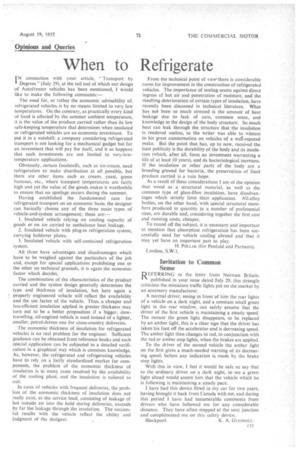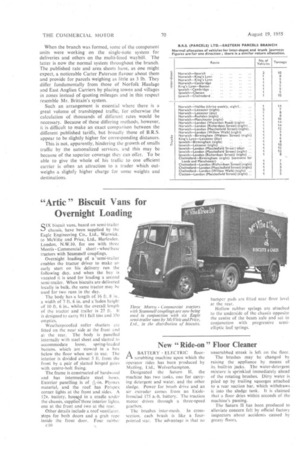When to Refrigerate
Page 54

Page 55

If you've noticed an error in this article please click here to report it so we can fix it.
IN connection with your article, Transport by
A Degrees" (July 29), at the tail end of which our design of Autofreezer vehicles has been mentioned, I would like to make the following comments—
The need for, or rather the economic advisability of, refrigerated vehicles is by no means limited to very low temperatures. On the contrary, as practically every kind of food is affected by the summer ambient temperature, it is the value of the produce carried rather than its low safe-keeping temperature that determines when insulated or refrigerated vehicles are an economic investment. To put it in a nutshell: a company considering refrigerated transport is not looking for a mechanical gadget but for an investment that will pay for itself, and it so happens that such investments are not limited to very-lowtemperature applications.
Obviously, certain foodstuffs, such as ice-cream, need refrigeration to make distribution at all possible, but there are other items such as cream, yeast, green bananas, etc., where transport temperatures are fairly high and yet the value of the goods makes it worthwhile to ensure that no spoilage occurs during the summer.
Having established the fundamental case for refrigerated transport on an economic basis, the designer can basically choose any of the three main types of vehicle-and-system arrangement; these are:—
I. Insulated vehicle relying on cooling capacity of goods or on ice carried to outbalance heat leakage.
2. Insulated vehicle with plug-in refrigeration system, carrying holdover plates.
3. Insulated vehicle with self-contained refrigeration system.
All three have advantages and disadvantages which have to be weighed against the particulars of the job and, except for special applications prohibiting one or the other on technical grounds, it is again the economic factor which decides.
The combination of the characteristics of the product carried and the system design generally determines the type and thickness of insulation, but here again a properly engineered vehicle will reflect the availability and the use factor of the vehicle. Thus, a cheaper and less-efficient insulation applied in greater thickness may turn out to be a better proposition if a bigger, slowtravelling, oil-engined vehicle is used instead of a lighter, smaller, petrol-driven one for cross-country deliveries.
The economic thickness of insulation for refrigerated vehicles is no real problem for the engineer. Sufficient guidance can be obtained from reference books and each special application can be subjected to a detailed verification in a graphical way which is common knowledge. As, however, the refrigerated and refrigerating vehicles have to rely on a fairly standardized market for components, the problem of the economic thickness of insulation is in many cases resolved by the availability of the cooling plant, and the insulation is tailored to suit.
In cases of vehicles with frequent deliveries, the problem of the economic thickness of insulation does not really exist, as the service load, consisting of leakage of hot outside air into the hold during deliveries, exceeds by far the leakage through the insulation. The successful results with the vehicle reflect the ability and judgment of the designer. From the technical point of view there is considerable room for improvement in the construction of refrigerated vehicles. The importance of sealing scams against direct ingress of hot air and penetration of moisture, and the resulting deterioration of certain types of insulation, have recently been discussed in technical literature. What has not been so much stressed is the amount of heat leakage due to lack of care, common sense, and knowledge in the design of the body structure. So much heat can leak through the structure that the insulation is rendered useless, as the writer was able to witness to his great consternation on vehicles of a well-reputed make. But the point that has, up to now, received the least publicity is the durability of the body and its insulation (which, after all, form an investment warranting a life of at least 10 years), and its bacteriological inertness. If the insulation or other parts of the body are a breeding ground for bacteria, the preservation of food produce carried is a vain hope.
As a result of these considerations I am of the opinion that wood as a structural material, as well as the common type of glass-fibre insulation, have disadvantages which strictly limit their application. All-alloy bodies, on the other hand, with special structural members produced in quantity in a number of preferential sizes, are durable and, considering together the first cost and running costs, cheaper.
To round off the subject, it is necessary and important to mention that absorption refrigeration has been successfully used for vehicle cooling abroad and that it may yet have an important part to play.
H. POLLAK (for Penfold and Partners). London, &WA.
Invitation to Common Sense
REFERRING to the letter from Norman Britain, published in your issue dated July 29, this strongly criticizes the miniature traffic lights put on the market by an accessory manufacturer.
A normal driver, seeing in front of him the rear lights of a vehicle on a dark night, and a constant small green light in the rear window, can safely assume that the driver of the first vehicle is maintaining a steady speed. The instant the green light disappears, to be replaced by an amber light, this is a clear sign that the driver has taken his foot off the accelerator and is decreasing speed. The amber light then changes to red, in conjunction with the red or amber stop lights, when the brakes are applied.
To the driver of the second vehicle the amber light on the first gives a much-needed warning of its decreasing speed, before any indication is made by the brake stop lights:
With this in view, I feel it would be safe so say that to the ordinary driver on a dark night; to• see a green light ahead would assure him that the vehicle which he is following is maintaining a steady pace.
I have had this device fitted in my car for two years, having brought it back from Canada with me, and during this period I have had innumerable comments from drivers who have followed me for any considerable distance. They have often stopped at the next junction and complimented me on this safety device.
Blackpool. K. A. GLEDH When the branch was formed, some of the component units were working on the single-note system for deliveries and others on the multi-lined waybill. The latter is now the normal system throughout the branch. The published rate and area sheets have, as one might expect, a noticeable Carter Paterson flavour about them and provide for parcels weighing as little as 3 lb. They differ fundamentally from those of Norfolk Haulage and East Anglian Carriers by placing towns and villages in zones instead of quoting mileages and in this respect resemble Mr. Brittain's system.
Such an arrangement is essential where there is a great volume of transhipped traffic, for otherwise the calculation of thousands of different rates would be necessary. Because of these differing methods, however, it is difficult to make an exact comparison between the different published tariffs, but broadly those of B.R.S. appear to be slightly higher for corresponding distances.
This is not, apparently, hindering the growth of smalls traffic by the nationalized services, and this may be because of the superior coverage the can offer. To be able to give the whole of his traffic to one efficient carrier is often an attraction to a trader which outweighs a slightly higher charge for some weights and destinations.








































































































